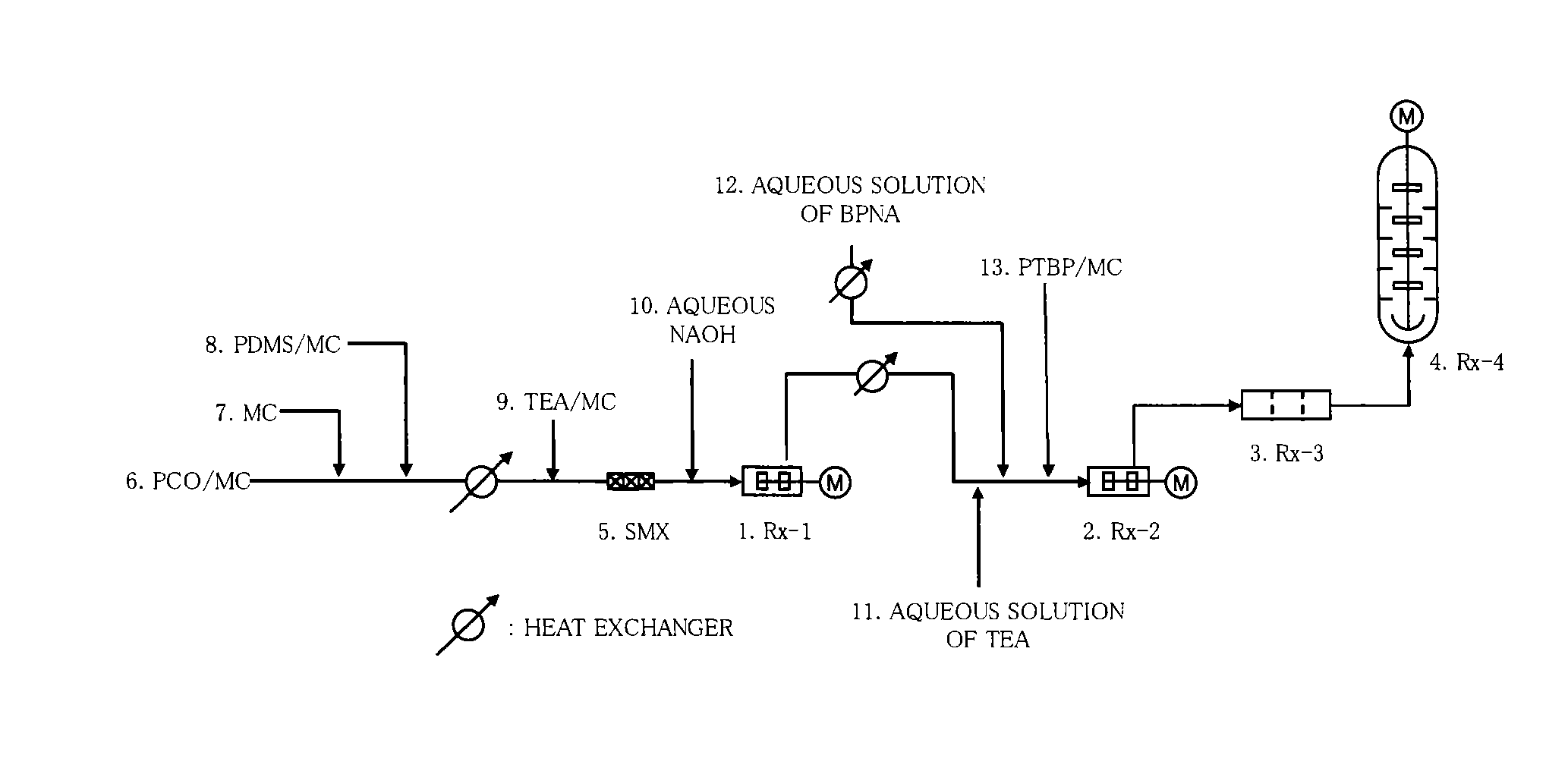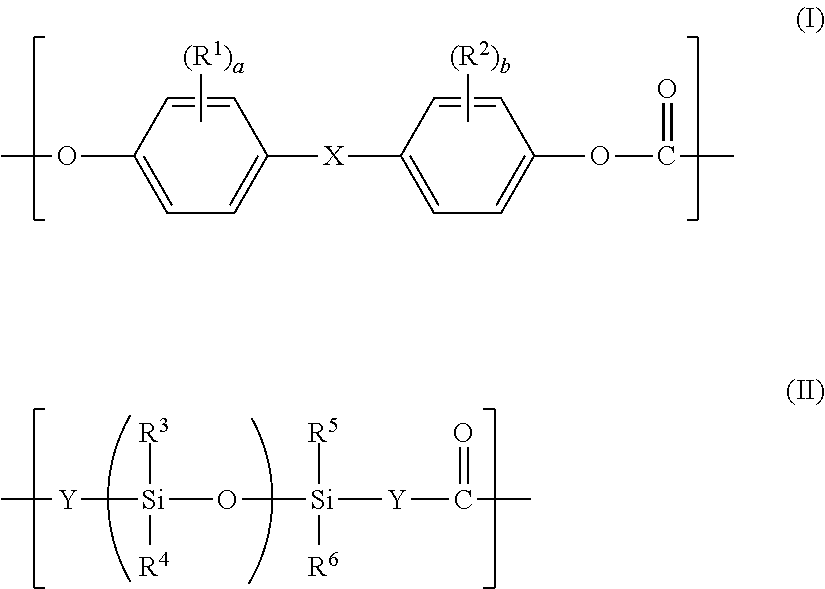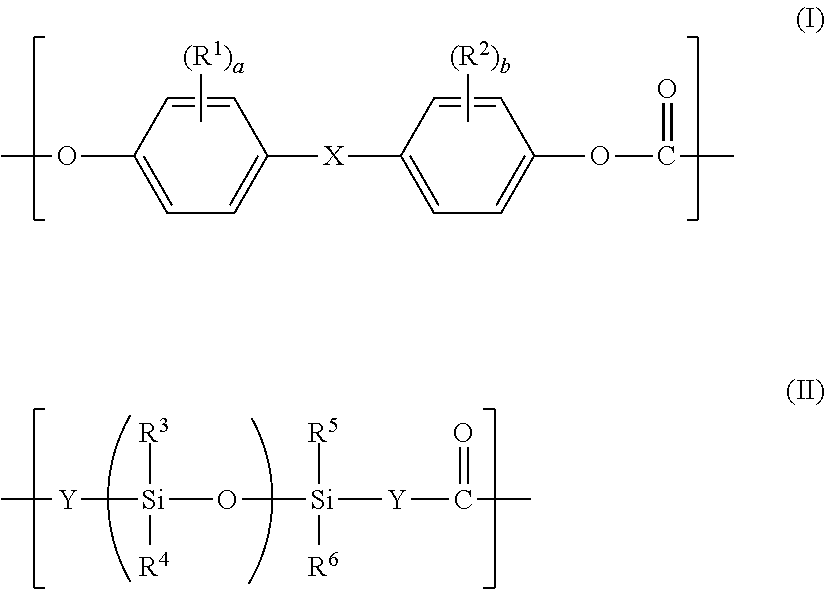Polycarbonate-polyorganosiloxane copolymer and method for producing same
a polyorganosiloxane and polycarbonate technology, applied in the field of polycarbonatepolyorganosiloxane copolymer and a method of producing the same, can solve the problems of insufficient transparency obtained merely by using a pdms-pc having a short chain length, inability to say that the copolycarbonate has transparency comparable, and insufficient transparency as compared with that of bpa-pc. , to achiev
- Summary
- Abstract
- Description
- Claims
- Application Information
AI Technical Summary
Benefits of technology
Problems solved by technology
Method used
Image
Examples
synthesis example 1
Synthesis of Polycarbonate Oligomer Solution
[0157]Added to a 5.6-mass % aqueous sodium hydroxide were 2,000 ppm by mass of sodium dithionite with respect to bisphenol A to be dissolved later. Bisphenol A was dissolved in the solution so that the concentration of bisphenol A became 13.5 mass %. Thus, a solution of bisphenol A in aqueous sodium hydroxide was prepared.
[0158]The solution of bisphenol A in aqueous sodium hydroxide, methylene chloride, and phosgene were continuously passed through a tubular reactor having an inner diameter of 6 mm and a tube length of 30 m at flow rates of 40 L / hr, 15 L / hr, and 4.0 kg / hr, respectively. The tubular reactor had a jacket portion and the temperature of a reaction liquid was kept at 40° C. or less by passing cooling water through the jacket.
[0159]The reaction liquid that had exited the tubular reactor was continuously introduced into a baffled vessel-type reactor having an internal volume of 40 L provided with a sweptback blade, and then 2.8 L...
example 1
[0162]A polycarbonate-polydimethylsiloxane copolymer was continuously produced with a production apparatus illustrated in FIG. 1. A method for the production is specifically as described below.
[0163]The polycarbonate oligomer (PCO) solution produced in Synthesis Example 1 and methylene chloride (MC) were mixed in piping at flow rates shown in Table 1 (concentration of the polycarbonate oligomer: 223 g / L). Then, a solution (PDMS / MC) of an allylphenol terminal-modified polydimethylsiloxane (PDMS) in which the repetition number n of dimethylsiloxane units was 40 in methylene chloride was mixed with the mixture in the piping. After that, the contents were sufficiently mixed with a static mixer (step (i)) and then the mixed liquid was cooled to 19 to 22° C. with a heat exchanger.
[0164]The cooled mixed liquid was mixed with a solution (TEA / MC) of triethylamine (TEA) in methylene chloride in the piping and then the contents were sufficiently mixed with a static mixer (step (ii)). After tha...
examples 2 to 4
[0171]Procedure was performed in the same manner as in Example 1 except that the flow rates of the respective raw materials and reagents were changed as shown in Table 1. Table 2 shows the respective physical properties of the resultant polycarbonate-polydimethylsiloxane copolymer.
PUM
| Property | Measurement | Unit |
|---|---|---|
| temperature | aaaaa | aaaaa |
| total light transmittance | aaaaa | aaaaa |
| total light transmittance | aaaaa | aaaaa |
Abstract
Description
Claims
Application Information
 Login to View More
Login to View More - R&D
- Intellectual Property
- Life Sciences
- Materials
- Tech Scout
- Unparalleled Data Quality
- Higher Quality Content
- 60% Fewer Hallucinations
Browse by: Latest US Patents, China's latest patents, Technical Efficacy Thesaurus, Application Domain, Technology Topic, Popular Technical Reports.
© 2025 PatSnap. All rights reserved.Legal|Privacy policy|Modern Slavery Act Transparency Statement|Sitemap|About US| Contact US: help@patsnap.com



